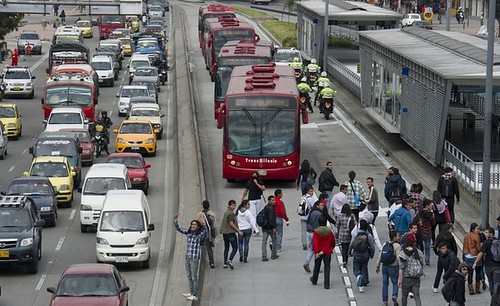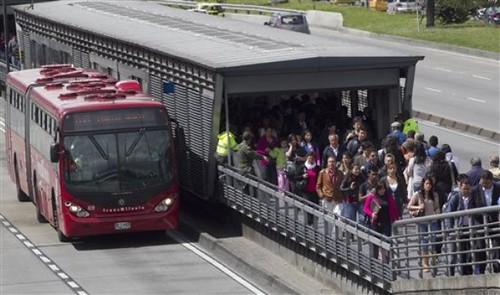BRT: an interesting contradiction
In South America, Bus Rapid Transit is successful because it serves transit dependent riders who possess limited mobility choices, while in North America it is promoted as a premium service to riders with choices.

This is quite a contradiction because part of the reason that BRT is successful in South America is because transit-dependent riders are willing (up to a point) to endure double the rider densities (crush loads double that of buses in the US), making a bus somewhat equal to a single subway car in terms of load, and in terms of finances, personnel costs are so much cheaper there.
In the US, BRT has mostly been promoted because it's cheaper than fixed rail service, and maybe that's ok because in many of the places where it's promoted there aren't the volumes of ridership that are necessary to justify fixed rail service anyway.
In other words, maybe the next step up from double the ridership of a regular bus service is higher quality bus service, BRT or otherwise, and the next step up from that is light rail.
But that doesn't mean that BRT as a higher grade service in North America can still solve the contradiction that requires choice riders to willingly give up the car for a bus, even if it is somewhat nicer and prettier than traditional bus service, but not as nice as traditional commuter bus express type service using "excursion" type buses which have much lower capacity.
(Jeff Tumlin of NelsonNygaard argues when well marketed, including a great transit pass system with financial support from employers, that bus service can be competitive with the car.)

From Applicability of Bogotá’s TransMilenio BRT System to the United States:
TransMilenio’s high capacity is also the result of high in-vehicle passenger loading. While the TransMilenio system was designed to carry seven standing passengers per square meter (SDG, 2000), capacity calculations in the U.S assume much lower standing passenger loads. This explains why the assumed capacities of different transit modes in the U.S context (10,000 to 12,000 for bus-based transit, 26,000 for LRT and 50,000 for HRT) (TCRP, 2003) are lower than the theoretical capacities of different transit modes presented by Vuchic (1992) (15,000 pphpd for bus-based transit, 30,000 pphpd for LRT, and 72,000 for HRT). If standard U.S passenger loadings are applied to the TransMilenio case, this would equate to a busway capacity of approximately 28,000 pphpd, similar to the assumed capacity of LRT systems in the U.S.
According to Samuel (2002), calculation of BRT system capacity in the U.S often is limited to only 10,000 to 12,000 pphpd because they do not take into account the very small headways that are possible with BRT. If these infrastructure requirements are met, it is possible to run buses at six to eight second headways (450 to 600 buses per hour per lane). This equates to a seated capacity of 27,000 to 36,000 passengers per hour. TransMilenio provides real-world proof of the validity of these calculations. The approximate tenfold headway advantage of buses over rail more than compensates for the additional capacity of a coupled rail vehicle over a single bus (Samuel, 2002).
While it seems crazy that it is possible to run buses at 6 to 8 second headways, there is no way in the United States that it is affordable to provide BRT at these capacities because of the personnel cost of having to have 450 to 600 bus drivers.
Labels: transit, transportation infrastructure, transportation planning





0 Comments:
Post a Comment
<< Home